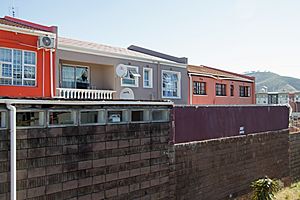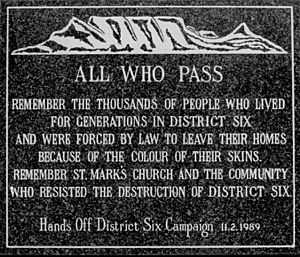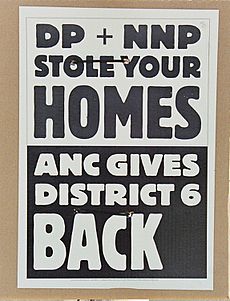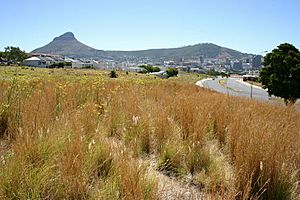District Six facts for kids
District Six (Afrikaans Distrik Ses) was once a lively inner-city neighborhood in Cape Town, South Africa. It was a place where many different people lived together, creating a vibrant community. However, during the 1970s, more than 60,000 of its residents were forced to leave their homes by the government. This happened because of a system called Apartheid, which separated people based on their race.
Today, parts of the District Six area are divided into the suburbs of Walmer Estate, Zonnebloem, and Lower Vrede. Other parts are still undeveloped land, waiting for people to return and rebuild.
Contents
What was District Six?
District Six was established in 1867. It was named the Sixth Municipal District of Cape Town. This area was special because it was home to a mix of people. There were freed slaves, merchants, artisans, and immigrants from different parts of the world. Everyone lived side by side, sharing their cultures and building a strong community.
The neighborhood was known for its busy streets, small shops, and unique architecture. It had a strong sense of community spirit. People helped each other, and children played together in the streets. It was a place where different cultures blended, making it a truly unique part of Cape Town.
Life in District Six
Life in District Six was often described as vibrant and full of energy. The streets were always busy with people going about their daily lives. There were many small businesses, like bakeries, tailors, and grocery stores. These shops were often run by families who had lived in the area for generations.
The community was also rich in music, art, and storytelling. Many famous South African musicians and writers came from District Six. They often wrote about their experiences growing up in this special place. It was a place where people felt a strong sense of belonging and identity.
The Apartheid Era and Forced Removals
Apartheid was a system of laws in South Africa that separated people by race. It treated white people as superior and gave them more rights. Black people, mixed-race people (called "Coloured" under Apartheid), and Indian people were treated unfairly. They were forced to live in separate areas and had fewer opportunities.
In 1950, the Apartheid government passed the Group Areas Act. This law allowed the government to declare certain areas "for whites only." In 1966, District Six was declared a "white area." This meant that all the non-white residents had to leave their homes.
Why were people forced to leave?
The government claimed that District Six was a "slum" and needed to be redeveloped. However, many people believe the real reason was to remove non-white people from a valuable inner-city area. The government wanted to create a segregated city where different racial groups lived in separate, designated areas.
The forced removals began in the 1970s. Families were given very little notice and were often moved to townships far away from the city center. These new areas lacked the facilities and community spirit of District Six. Homes were bulldozed, and the vibrant neighborhood was turned into an empty space.
Impact on the Community
The forced removals caused huge pain and suffering. Families were torn apart, and a strong community was destroyed. People lost their homes, their businesses, and their sense of belonging. Many residents had lived in District Six for generations, and suddenly, everything they knew was gone.
The empty land of District Six became a symbol of the cruelty of Apartheid. For many years, the area remained largely undeveloped. This was a constant reminder of the injustice that had taken place.
The Legacy and Return
After Apartheid ended in 1994, efforts began to help the former residents of District Six return to their land. The District Six Museum was opened to remember the community and tell its story. It collects memories, photographs, and artifacts from the people who lived there.
The process of returning the land to its original owners has been slow and challenging. Many former residents have passed away, and their children and grandchildren are now fighting for their right to return. New homes are slowly being built on the land, but the spirit of the old District Six is hard to recreate.
Rebuilding the Community
Today, there are ongoing projects to rebuild parts of District Six. Some former residents have been able to move back into new homes. These efforts aim to heal the wounds of the past and create a new, inclusive community. However, the memories of the forced removals remain a powerful part of South Africa's history.
The story of District Six is an important lesson about the dangers of discrimination and the importance of human rights. It reminds us of the strength of community and the resilience of people in the face of injustice.





